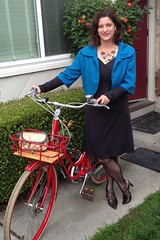What makes a bicycle a bicycle? Ask the Department of Motor Vehicles and it’s a device a person rides that’s propelled by human power through a system of belts, chains, or gears and has two or three wheels with at least one wheel bigger than 20 inches. Ask the UCI, racing cycling’s governing body and the answer for road bikes is much more specific, including weight limits (at least 15 pounds), and geometry requirements (triangle frame, equal sized wheels). It even has standards for saddle length (24-30 cm).
The designers of most bikes are not bound by UCI regulations, which makes the “Pedal Power: From Workhorse to Wacky” exhibit currently running at the Los Altos History Museum so intriguing. From penny farthings to recumbents, from wooden bikes to bamboo, from cruisers to folding bikes, to bikes too hard to describe, you’ll see them all. For the purists there are historic racing bikes from Greg Lemond that meet the UCI regulations, plus a variety of mountain bikes from the pioneer builders that screamed down Mt Tam.

The opening reception for the exhibit is next Sunday evening but I rushed to get there early. I had met one of the contributers at the Wine, Women & Chocolate party who asked if they could display one of my photos. I sent her a link to my Flickr photostream and she said she found one she liked for the display on town bikes. To my surprise, I found several more photos I took of family and friends in the “Wear What You Like… Go Where You Want” section, along with some lovely shots of Los Altos native Melissa of Bike Pretty.
I’ll have to go back for the opening reception, though. I spent so much time talking to Jan the exhibit’s designer about her options for buying a city bike that I didn’t get to read all the displays. Plus bike builder Craig Calfee will be there to talk about how bike designs have changed over time. If you’re on the San Francisco Bay Area, I’d love to meet you too. It’s Sunday, April 27 from 4-6 pm. Admission is free. (details).
- The Pedal Power exhibit tells the history of bicycles, starting with a penny farthing with adjustable cranks.
- The Swiss Army Bike may be vintage but its timeless design is still found in city bikes today.
- This Cycle Gitane bike was the first bike Tour de France winner Greg Lemond rode after turning pro in 1981.
- Not sure the wheels on this Tikit folding bike meet the DMV bike definition.
- Beach cruiser bikes, like this one by Electra, set the standard for comfort.
- Hey, look! That’s me and my Viva Juliett in the town bike description.
- Female pioneers and the bicycle’s role in women’s liberation were duly noted.
- That’s my mom, my sister Susan, and friends Leah, Pat, Melissa & Rebecca.
- The creativity of bike builders knows no bounds.
- From welding frames together for tall bikes. (yes, it’s rideable)
- To using materials like wood and bamboo for frame materials.
- To coming up with strangely practical applications for two (or three) wheels.



















Stuart M.
April 21, 2014 at 2:10 am
As you mentioned, the Tickit with its 16 inch wheels doesn’t fulfill the 20 inch wheel requirement of the DMV definition of a bicycle. Neither does the Brompton which also has 16 inch wheels. I wonder if these “toys” are not considered bicycles, can one ride them on the sidewalk? Not that I want to, it just seems a strange standard for the DMV to have come up with. I’m sorry I won’t be able to see the exhibit or meet you since I live in Japan.
ladyfleur
April 21, 2014 at 7:09 am
I suspect the 20 inch wheel requirement was added to exclude bikes ridden by small children, so that small kids could be allowed to ride in ways not permitted for adults (e.g. on sidewalk). It may have been written before the 16 inch wheel bikes like the Tikit and Brompton became available and they didn’t bother fixing it. I wonder if any Californian has fought a ticket and won it based on this loophole?
Gary Hedden
April 23, 2014 at 6:39 pm
Hi Janet,
Great post. I’m looking forward to meeting you Sunday.
Gary Hedden
ladyfleur
April 23, 2014 at 10:06 pm
Gary, your team hit it out of the park with this exhibit. Between what the Mountain View Library is doing with their series of bike activities and the Los Altos History Museum is doing with Pedal Power, I’m really excited to see local groups outside the bicycling community being such great supporters. I shouldn’t be so surprised, though. Bikes are fun.